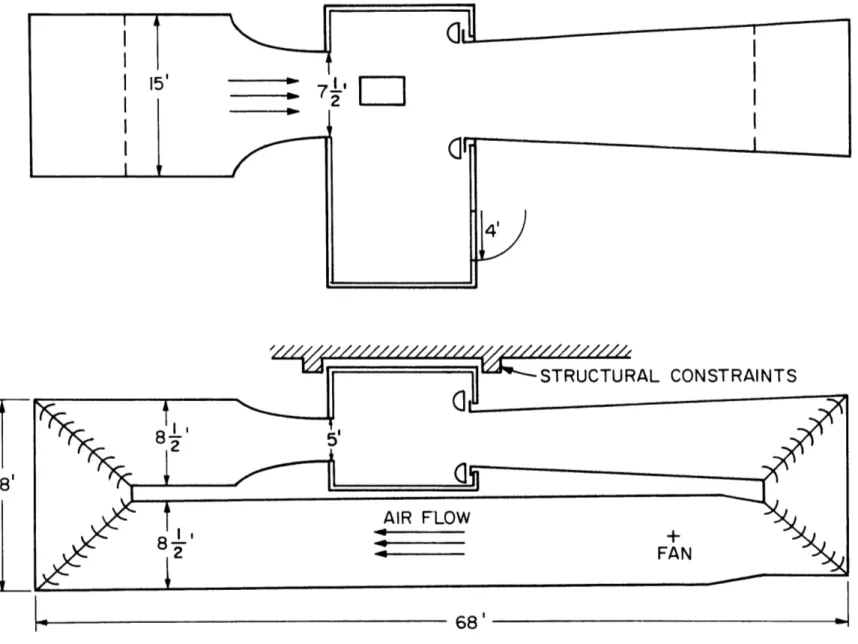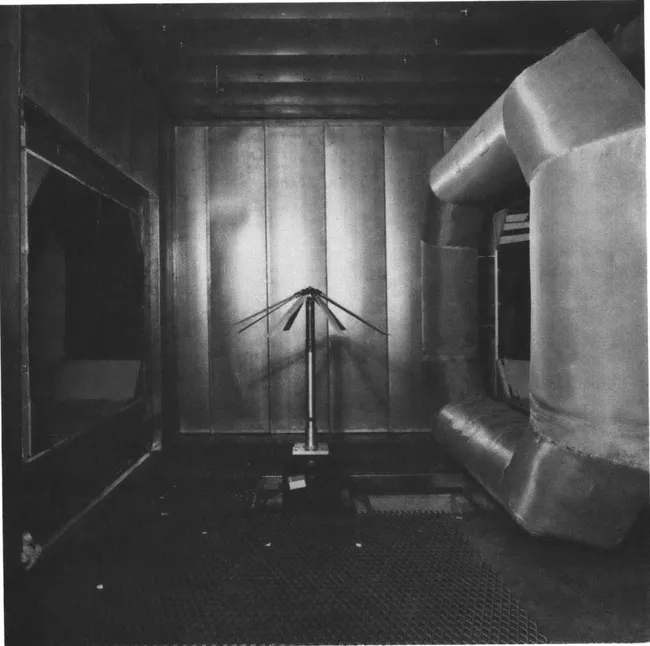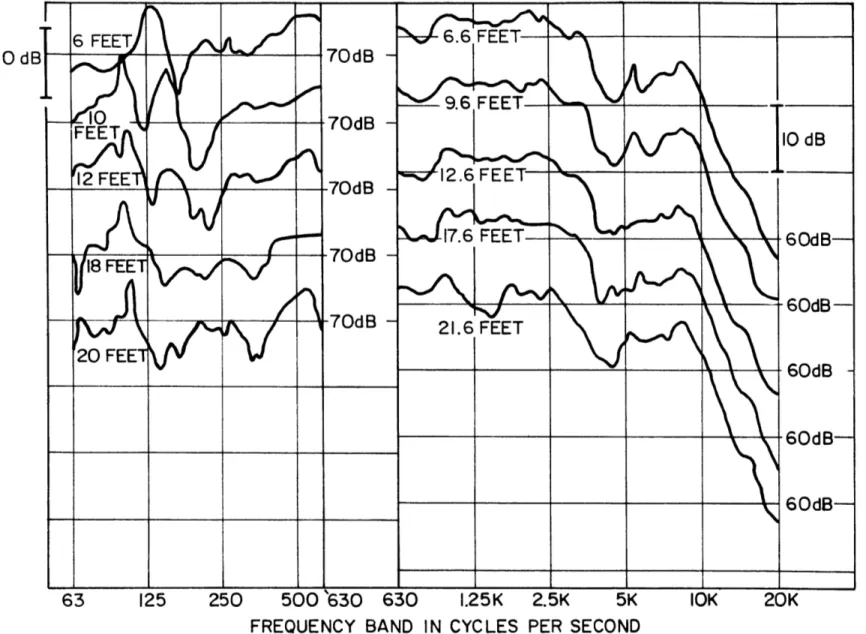THE DEVELOPMENT OF
A WIND TUNNEL FACILITY FOR
THE STUDY OF V/STOL NOISE
Paul Bauer
Sheila Widnall
August 1972
MASSACHUSETTS INSTITUTE OF TECHNOLOGY FLIGHT TRANSPORTATION LABORATORY
FTL Report R-72-6
August 1972
THE DEVELOPMENT OF A WIND TUNNEL FACILITY FOR THE STUDY OF V/STOL NOISE
Sheila Widnall and Paul Bauer
This work was sponsored by ARO Durham under Contract No. DAHC04-69-C-0086.
ABSTRACT
An open-jet wind tunnel operating within an anechoic chamber was developed for the purpose of the study of V/STOL noise mechanisms. An existing low-speed conventional hard-walled wind tunnel was modified to operate as an open-jet tunnel; an anechoic chamber was then constructed around the test section. The resulting aerodynamic and acoustic char-acteristics of the tunnel are discussed.
This work was sponsored by ARO Durham under contract # DAHC04-69-C-0086.
INTRODUCTION
In the design of a complex V/STOL configuration it is often very difficult to predict the characteristics of the aerodynamic noise generated by the propulsion and lift system before the vehicle is built and flown. This is particularly true if the noise generation characteristics
are strongly affected by the effects of forward speed, as for example a VTOL rotor. For many reasons it is difficult to obtain a complete understanding of this aero-dynamic noise generation from flight tests.
In a flight test, background noise, acoustic transmission, absorption and reflection characteristics of the test sight and wind gusts make valid acoustic data difficult to obtain. In addition it is difficult to measure the aerodynamic events on the vehicle simultaneously with the noise that they radiate. The time varying character of the signal in a fly-over makes interpretation of the signal difficult. Directivity information is seldom obtained. Even if valid acoustic data on a known
vehicle configuration and operating condition could be obtained, the constraints of flight tests make the variation of parameters over a wide range impossible. It is not possible to turn off the engine or rotors (if any) to assess their contribution to the acoustic signal separately and still maintain a simulation of powered flight. The expense of flight tests and full-scale hardware development reduces the ability to make design changes
and determine their effect on system performance and radiated noise.
If this situation existed in the design and operation of flight vehicles it would be analogous to being unable to measure
the aerodynamic characteristics of a vehicle until after it was built and flown, and the effect of all design modification would be studied directly by flight tests on the full-scale vehicle.
The obvious solution to these problems is proper simulation of the vehicle and the important aerodynamic and acoustic
interactions in a wind tunnel. Wind tunnel testing for per-formance and aerodynamic characteristics is a valuable and standard technique. Wind tunnel simulation of and proper measurement of acoustic phenomena resulting from unsteady aerodynamic interactions is a more recent development.
Current subsonic wind-tunnel test sections are of two
types, the standard hard-wall closed-jet section and the more recent open-jet-in-an-anechoic-chamber test section. These latter tunnels are especially designed to make simultaneous aerodynamic noise in a conventional hard-wall tunnel is very difficult. Since these tunnels were never designed for noise measurements they usually have a high level of background noise, predominately from the tunnel fan. Simply placing a microphone in the test section to measure noise from a model
rotor gives rise to additional problems. Wall reflections will make interpretation of the sound measured at a point very
difficult and a microphone placed in a high velocity stream of air has induced an extraneous "self generated noise" signal. The tunnel turbulence will also act as a souce of psuedo-sound
to a microphone placed in the wind stream.
Compressible blade slap has been studied on a full-scale rotor in the NASA Ames 40' x 80' tunnel. In these tests, the blade slap was such an intense noise source, that the signal
noise. However, it is more difficult to study such problems as main-rotor vortex noise or less severe blade slap using conventional wind tunnels. Even if the tunnel is quite and the microphone-self-noise and pseudo-sound problems have been solved, perhaps with data reduction techniques, wall
relfections still make it difficult to obtain valid directivity and overall sound-power data.
In 1969, there were available acoustic tunnels with small test sections. For example, the acoustics and vibration labor-atory tunnel at MIT1 has a test section 15" x 15". We have used this facility to simulate some of the details of sound radiated by a blade that cuts through a tip vortex. However, we felt that it would be valuable to have an experimental fac-ility where simultaneous aerodynamic and acoustic measurements
could be performed in a controlled environment on complete
model rotors and complex STOL configurations of such a size that proper Reynolds number and Mach number scaling could be obtained.
In the next section, the modifications to an existing large
subsonic wind tunnel necessary to obtain valid data on aerodynamic noise radiated by V/STOL configuration are discussed.
DISCUSSION OF THE ACOUSTIC MODIFICATIONS TO THE SUBSONIC TUNNEL The dimensions of the original hard wall test section were 5' x 7 '; the top speed was 140 ft/sec. The modifications to the tunnel lead to a quiet open-jet tunnel of dimensions 5' x 7 ' with a top speed of 115 ft/sec. operating within an anechoic
chamber. Modifications to the tunnel included the necessary mufflers to quiet the tunnel fan in the frequency range of
interest. (above 250 Htz)
to a large open-jet operating within an anechoic chamber as compared with a conventional hard-walled wind tunnel. Noise measurements can be made in the low-velocity region beyond the jet which reduces the problem of microphone "self-generated" wind noise and pseudo-sound due to tunnel turbulence. The absence of wall reflections in the anechoic environment
makes possible detailed studies of the directivity of the sound field. This combined with the ability to simulate the aero-dynamics of V/STOL configurations in forward flight makes it possible to obtain the directivity of V/STOL noise as a function of flight condition.
If good Reynolds number similarity has been obtained in an aerodynamic noise experiment, the frequencies will scale with the flow velocity and a typical length. If the testing on the model rotors of say 1/6 to 1/10 scale is carried out at essentially full-scale speed, the frequency measured would scale to the actual rotor as the inverse of the model scale, that is 6-10 times actual frequency. For a tunnel (and rotor) speed of half of full scale speed, the frequency obtained would be 3-5 times full scale. This upward shift in the frequencies of of interest is very beneficial in the design of the anechoic
facility. Muffler size, depth of anechoic treatment, and the required size of the anechoic chamber scale directly with the wavelength of sound at the lowest frequency of interest. For the space available and the tunnel size, 250 htz was chosen as a lower bound on the frequency range at which a free field sim-ulation could be obtained in the facility. The acoustic wavelength
at 250 htz is about 4 feet. This characteristic dimension sizes (a) the mufflers for the tunnel fan, a depth of
A/4
of absorbingmaterial is required, (b) the anechoic chamber, measurements should be made at least)from the noise source, and (c) the depth of anechoic treatment on the chamber walls. The
requirements on the construction of the chamber also become more severe at lower frequencies.
1. Tunnel Layout and Structural Design
The tunnel is closed-return with a 100 Hp variable speed DC motor with a low-solidity constant-pitch propeller (fan). The overall layout of the tunnel is shown in Figure 1. A photograph of the test section appears in Figure 2.
The tunnel is located in the basement of Building 33 at MIT. The surrounding walls, floor and ceiliig are concrete. The structural elements of Building 33 are indicated near the test section area.* Of necessity we took these structural elements as constraints on our tunnel design.
We were somewhat constrained by structural limitations both on the size of the anechoic chamber and the weight which could be added in this section of the building. We engaged the struc-tural engineering firm of Cleverdon, Varney and Pike, Boston, Massachusetts to certify the additional load carrying capacity of the building. We also engaged the acoustical consulting
firm of Cambridge Collaborative to design a light weight yet effective anechoic chamber (to be described in greater detail shortly). In the end a chamber weighing 10,500 lbs. was de-signed and built. This additional weight was suspended from the ceiling above the test area.
* See also Figure 7.
---2. Acoustic Modifications a) Tunnel Background Noise
The original background noise in the tunnel test section (at top speed) appears in Figure 3. This measurement was taken with a B & K
"
microphone flush mounted near the nose of a 4" diameter sphere. This technique, in which the microphoneoperates under a laminar boundary layer, allows the measurement of acoustic pressures without the usual micrphone-self-noise
problem. There are, however, pressure fluctuations due to tunnel turbulence which act as psuedo-sound to the microphone.
Acoustic treatment was first applied to the two vertical walls at either end of the tunnel. The treatment consisted of a
step-wedge of Gustin-Bacon Ultralite fiberglass. The wedge detail is shown in Figure 4. This wedge was chosen to attenuate acoustic energy above 250 cps.
The background noise measured in the tunnel after this treatment was applied is also shown in Figure 3. The results show an increase of noise at low frequencies and a decrease in noise at high frequencies. Short of removing the acoustic wedges this result cannot be easily verified. When the hard
tunnel walls were removed, the background noise in the tunnel was further reduced since the acoustic engery is no longer
confined to the test section.
The next acoustic treatment was applied to the turning vanes. This was an Owens-Corning #338 fiberglass Blanket applied to the lower surface of the turning vane, covered
with a 30% perforated steel sheet; this is sketched in Figure 5. When the background noise is measured outside the test
section a large reduction is obtained as discussed previously. This is not due to microphone self-noise. It is more likely due to the absence of the psuedo-sound caused by the tunnel turbulence impinging on the microphone as well as some
channel-ing of the tunnel fan noise by the turnchannel-ing vanes straight through the test section.
When the anechoic chamber was installed around the chamber, a further decrease in background noise was obtainedgmost likely due to the absorbative walls and the absence of reverberations.
One final comment on the interpretations of total reduction achieved in acoustic background noise should be made. Because
the measurements in the test section most likely contained pressure fluctutations due to tunnel turbulence, it is dif-ficult to assess the effects of individual changes before the tunnel walls were removed allowing a true measurement of
acoustic engery. Therefore one cannot, without some ambiguity, isolate the acoustic effect of each modification from these measurements of tunnel background noise.
The tunnel noise was found to increase with increasing
(U test section velocity); the spectrum of the tunnel background noise scaled with strouhal frequency (f DAJ constant).
There-fore, at lower test section speeds, the level of tunnel back-ground noise is correspondingly lower and the energy shifts
b) Acoustic Performance of Modifications, Transmission Loss In order to separate the acoustic effects of the tunnel modifications from the aerodynamic effects, transmission-loss measurements between the return section and the test section and anechoic chamber were made. Because of the complex internal gometry of the tunnel, these measurements give only a qualitative idea of the effect of the modifications. The test procedure is sketched in Figure 6. A loud speaker was placed in the return
section and acoustic measurements were made at points A (return section) and B (test section). The difference (in db) in these two measurements is the transmission loss (TL) of the path. In this case there are three paths, two air paths, up and down-stream in the tunnel, and a structural path through the ceiling of the return section. At this early stage in construction, no attempt was made to investigate each path separately.
Figure 6 shows the effect of the various modifications on the transmission loss. After the addition of the wedges on
the vertical end-walls, about 10 db in TL at moderate frequencies was obtained. Removing the test section gave an additional
TL due to a reduction in the reverberant field in the test section.
We interpreted these measurements to mean that the solid sheet metal turning vanes were turning the high frequency acoustic energy and beaming it into the test section. We
therefore applied acoustic treatment to the turning vanes, (as described in this report). At this same time, the panels of the anechoic chamber were also being installed so that the TL
of the turning vane modification alone was not measured. The final measurement of TL was made with both the treated turning vanes and the anechoic chamber. These measurements show a significant additional TL due to the
combination of the turning vanes and the anechoic surround-ings. These results also show a 3 to 6 db difference between measurements made within the test section and at a point
within the chamber. This is believed to be partially due to a beaming of the sound by the turning vanes directly through the test section.
3. Anechoic Chamber
a) Design and Construction
The anechoic chamber was designed by Cambridge Collaborative, an acoustical consulting firm. The overall dimensions,
lay-out and mounting details are shown in Figure 7 through 12. The panels were supplied by Barry controls. The panels were designed primarily for transmission loss. They are 4" thick, made of sheet metal covered with a porous metal face and
filled with fiberglass. The panels weigh approximately 6 lbs. per sq. ft. The ceiling and wall panels were hung from the
ceiling beams; the floor panels were vibration isolated from the existing floor (see Figure 8). The area around the model well and tunnel were sealed as indicated in Figures 10 and 11.
b) Acoustic Performance
Although the panels are desinged primarily for trans-mission loss, the fiberglass filling provides an adequate anechoic environment for many of our experiments.
The limit of free field conditions within the anechoic chamber was explored by placing a loudspeaker at one end of the room and measuring the spectrum at several points. Figure 13 shows the results of such an experiment .
Each spectrum was taken at a different distance along a line from the source and then connected to allow for geometric spreading. (6 db per doubling of distance). To allow the in-dividual spectrum to be seen, the scale for each sprectrum has been shifted by 10 db. If perfect free field conditions exist,
these curves should all be parallel and shifted by 10db.
A good simulation of free field is obtained above 630 Hz. Some scatter is seen between 250 and 630 Hz. Additional fiber-glass will be used if necessary to obtain data in this fre-quency range.
Below 250 Hz. large standing waves can be seen in the measured data as would be expected. Acoustic measurements in
this range of frequencies would provide qualitiative information only. One could also obtain the relative effects of changes in parameters (e.g., forward speed).
4. Tunnel Aerodynamic Design and Performance
The aerodynamic modification to the tunnel consisted of:
1. removing the tunnel walls surrounding the test section. 2. installing a large slotted cowl at the entrance to the
diffusor.
This does not result in an optimum aerodynamic design for an open-jet wind tunnel.
Since the tunnel was originally designed as a closed-jet tunnel the gradual increase in test section size to accommodate the turbulent boundary layer is not rapid enough for the open turbulent jet. For this reasons we are considering a future modification which will reduce slightly the upstream area of the jet. (This will also raise the test section velocity.) The open diffusor was fitted with a rounded cowl backed by an open slot (Figure 1) which served to stabilize the flow; when this slot was covered, violent oscillations of the jet and
indeed the entire tunnel occurred. This slotted cowl is very similar to that proposed for the facility at David Taylor Model
3
Basin (NSRDC) . The effect of the modifications was to reduce
the tunnel speed from 140 fps to 115 fps.
The mean flow profile across the test section in the horizontal direction at 88 fps is shown in Figure 14. The
level and spectrum of the tunnel turbulence in the center of
the test section is shown in Figure 15. As can be seen from these figures, the mean velocity is uniform across the test section
with a slight overshoot near the jet boundary. The overall tunnel tubulence is about 1% with a spectrum which peaks at about 200 htz.
References
1. Hanson, C.E., The Design of and Construction of a Low-Noise Low-Turbulence Wind Tunnel, DSR 79611-1 EPL Report,
Department of Mechanical Engineering, MIT, (1969).
2. Aidala, P.V., "Acoustical Diagnosis of the Anechoic Wind
Tunnel", 16-62 Project Report, MIT, Department of Aeronautics and Astronautics, (1971).
3. Bilger, R.W., Aerodynamic Design of An Anechoic Test Facility,Nort. Res. and Eng., Report 1057-1 (1962).
[- 68'
0 SPL MEASUREMENT ON G/L WITH~ ______ UPSTREAM TURNING VANE
10IIO COVERS V,- I1O F.P.S.
o0 SPL MEASUREMENT BEFORE 0 LU 1~~~zl0 FTS.FRM/LFOE 0-30 . 50 80E 200 315 50PS0.25 J25
05
SP MESUREMET MCONPC/OWNT ui UPTREAMTUFRNIN VANOEN COVERS V-~ 11 FPS. ~ SPL MESUREMENT BFROR / E za 90 TACO ST TRETEONTAEH 0 ~V14 FR N LC z~JE V.-..5 115. S V lll5FPS 200 38050 0012502,0 1 40 63550 0 160 20 41 00 630 100 2600 250 4000 6300 1000 ,000 5,0 ONE-THIRD OCTAVE BAND CENTER FREQUENCIES (Hz)FIG. 3 SPL MEASUREMENTS OF BACKGROUND NOISE IN TEST SECTION CORRECTED TO 1/3 OCTAVE BANDWIDTH
FIG. 4 ACOUSTIC WEDGE DETAIL FLOW 30% PERFORAT SHEET # 12 GAUG
FIG. 5 CROSS SECTION OF TURNING VANE
x TUNNEL BEFORE MODIFICATIONS
or A ACOUSTIC WEDGES ADDED TO END WALLS
_40 o ACOUSTIC WEDGES ADDED TO CEILING
N AND FLOOR
o
o REMOVAL OF CLOSED TESTO SECTION
o
30 ANECHOIC ROOM INSTALLED O ir 20z
2O d w-10ONE-THIRD OCTAVE BAND CENTER FREQUENCIES (Hz) FIG. 6 MEASUREMENT OF THE AT TENUATION OF A NOISE
ENCLOSURE PANELS ABSORPTIVE-HIGH TL PANELS 4 THICK TEST SECTION DIFFUSOR WOOD FLOOR
FIG. 7 CROSS SECTION OF MIT OPEN JET WIND TUNNEL
CONCRETE BEAM BOL~TS PIN TL PANEL CEILING /~4'" 6" STEEL RIVET / 4RT BOLT 3/ 8 1x 5"
K
TI
PANEL WAL L VERTICAL PANELS HUNG FROM "C" BEAM "L BEAM ISOLATION MOUNT VERTICAL PANELS HUNG FROMRIGHT ANGLE BEAM
FIG. 9. VERTICAL PANEL LOWER SUPPORT DETAIL
FIG. 8 VERTICAL PANEL SUPPORT DETAIL
/ 16kx 4" DOUBLE "C" BEAM MOUNTING PLATFORM _ FLOOR PANELS I -PIN TL PANEL GLASS FIBER' 2'x4 - METAL SCREWS
,-LEAD VINYL SHEET
2#/ft2
-*-CLOSED CELL FOAM
WIND TUNNEL WALL
FIG. II ENCLOSURE TO TUNNEL CONNECTION DETAIL /
t0 DIFFUSOR DOUBLE 2'x 9
INLET DOOR TL
7' 4' 1>ANEL!
30
1Od
FREQUENCY BAND IN CYCLES PER SECOND
65
JET ENTRANCE
50 -0 48 FROM TUNNEL MOUTH - --
-a 8" FROM TUNNEL MOUTH o 77.5" FROM TUNNEL MOUTH 45
40
0 10 20 30 40 50 60 70 80 90
DISTANCE FROM LEFT SIDE OF TUNNEL (INCHES) (LONG SIDE OF ANECHOIC ROOM)
0.1%
6% BANDWIDTH FREQUENCY FILTER 0.01%
---0.001%
20Hz 63Hz 20OHz 630Hz 200OHz 6300Hz 20K-Hz
FIG. 15 FREQUENCY SPECTRUM OF TUNNEL TURBULENCE TOTAL TURBULENCE









